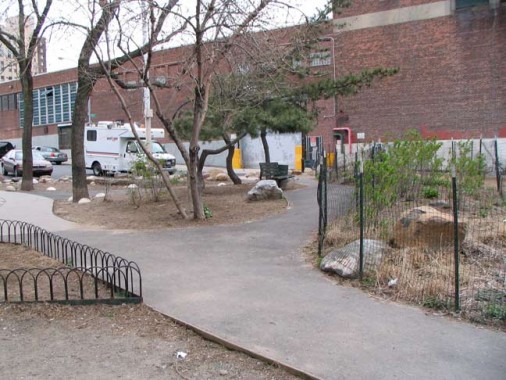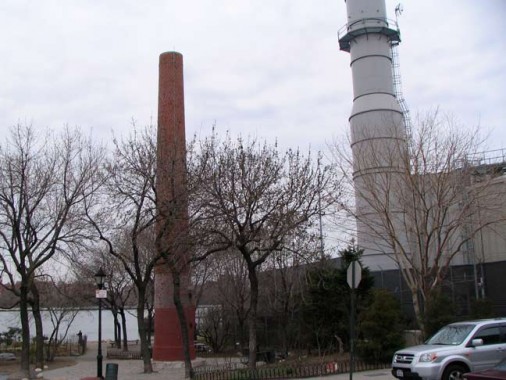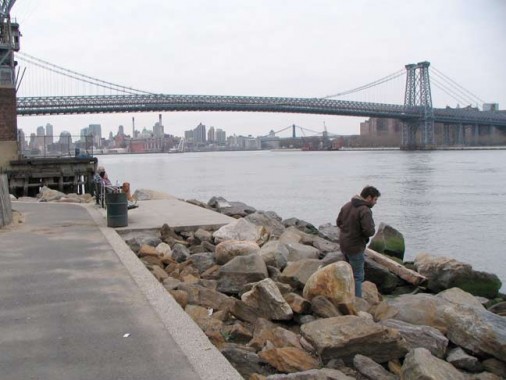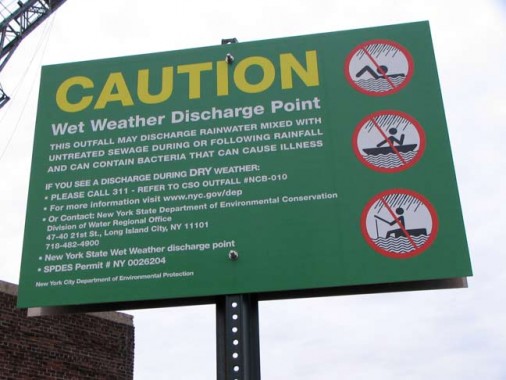Tucked away at the west end of Grand Street where it meets the East River and punctuated by a tall smokestack you’ll find a small oasis that indirectly remembers the founder of Williamsburg, once a city on its own before being absorbed by Brooklyn in 1855.
Williamsburg grew out of a ferry service instituted in 1802 by entrepreneur Richard Woodhull between what became Metropolitan Avenue and Corlear’s Hook, Manhattan, at the bend in the East River just south of where Manhattan’s Grand Street meets the river. Soon after that the Wiliamsburg and Jamaica Turnpike, originally a toll road, began carrying traffic from the river to the town of Jamaica; that road evolved into Metropolitan Avenue.
Shortly after, Woodhull purchased 13 acres of territory from farmer Charles Titus near the ferry and named it after his surveyor, Colonel Jonathan Williams, a grandnephew of Benjamin Franklin. Today, Woodhull is remembered by Woodhull Hospital at Broadway and Flushing Avenues, though he went bankrupt in 1806. Service continued until 1918, fifteen years after the Williamsburg Bridge opened.
Forgotten Fan John Dereszewski, in Comments:
The Grand St. park marks the site of the ferry that was established by Thomas Morell just after the turn of the 19th century. Morell established a community called Yorkton, which proved to be successful. At the same time, Woodhull established a ferry and the Williamsburg community a few blocks north where Metropolitan Ave. reaches the river. Unlike Yorkton, it went bankrupt. However, the name caught on while Yorkton did not. In addition, the original layout of Williamsburg, with its north and south sides flanking Grand St. was the work of Morell, who is definitely the most neglected founder of Williamsburg. (A street was named after him in what is now East Williamsburg, but it was first partially incorporated into a portion of Bushwick Ave. and the remaining segment was eliminated by the construction of Bushwick-Hylan Houses.)

What became Grand Ferry Park opened as an informal open space in 1974, but it took 23 years until NYC Parks formalized the arrangement and anointed it as a public park.

The park is notable for its 70-foot brick smokestack. It was constructed by Pfizer Chemical Co. to process molasses, which aided in the manufacture of penicillin. The brick pavement stones surrounding the smokestack were salvaged by Parks from Grand Street itself.

Boulders at the park’s edge at the waterline, called riprap, protect the park paths from erosion. The paths provide excellent views of the Williamsburg Bridge and the Manhattan Bridge in the distance.

Though a trench diverts rainwater into the river, stopping it from overflowing in the park, this had the unfortunate side effect of diverting toxic chemicals into the river. All things considered, though, NYC’s major waterways are much cleaner now than they’ve been for decades, though smaller ones such as Gowanus Canal and Newtown Creek will take decades, if not the greater part of a century, to bring back to any semblance of cleanliness.
1/15/13


6 comments
I jogged past this park for the first time only four days ago. It oozed character and I was wishing I knew something about it. And, now, I do. Thank you.
Kevin, thanks for placing this post, but a big correction is in order.
The Grand St. park marks the site of the ferry that was established by Thomas Morell just after the turn of the 19th century. Morell established a community called Yorkton, which proved to be successful. At the same time, Woodhull established a ferry and the Williamsburg community a few blocks north where Metropolitan Ave. reaches the river. Unlike Yorkton, it went bankrupt. However, the name caught on while Yorkton did not. In addition, the original lay out of Williamsburg, which its north and siuth sides flanking Grand St. was the work of Morell, who is definitely the most neglected founder of Williamsburg. (A street was named after him in what is now East Williamsburg, but it was first partially incorporated into a portion of Bushwick Ave. and the remaining segment was eliminated by the construction of Bushwick-Hylan Houses.
This park has a special place in my heart. When I was working for a City Councilman in the 1970’s, I played a role in getting Pfizer to contribute some funds in establishing an informal park at this site. After that, as a member of Brooklyn Community Board 1, I advocated for the establishment of the Grant Street ferry as a city park. So, whenever I am able to visit this lovely park, I have a good sense of accomplishment.
Thanks — added in text.
Well done and Thank you John for preserving a piece of history, green space and getting cooperatiive action between various parties.
John,
I’m doing some research about this for a project. Do you know any more info about Thomas Morell? Are there any books about him or his ferry service?
My father ran the one-time Pfizer terminal at the foot of Grand Street. The job also included a home — where my family lived for two years. Our house was part of a structure that housed the massive boiler that generated steam used to keep the molasses flowing. The chimney that remains was used to vent that boiler. Living “on the waterfront” was pretty cool for a kid. We got to go aboard large tanker ships that delivered molasses, as well as oil to the NEPCO tanks to the North. However– living in industrial Williamsburg surrounded by factories — was also mighty isolating for a kid — so we decided to move back to Queens. Pfizer meant a lot to the old man. He worked there for 46 years. Never lost a day to a shutdown. I guess what is most incredible to me how Williamsburg went from a place you didn’t want people to know that’s where you lived (One of brother’s teacher’s called him “The Troll” because we lived under the Williamsburg Bridge.)– to a place you could never afford to live. Not sure which one is better.